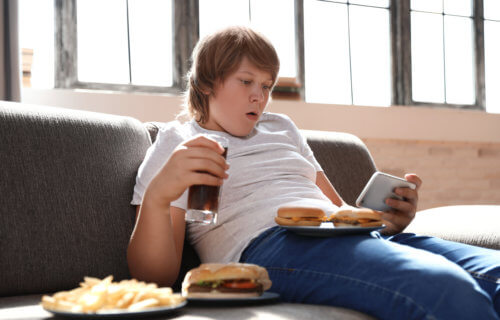SOPHIA ANTIPOLIS, France — Unhealthy lifestyles — or being a “couch potato” — can lead to health problems at any age. However, a new study finds children as young as six could develop high blood pressure because of this inactivity.
According to researchers, overweight youngsters are spending too much time on their sofas and not enough in the park playing sports or just staying active. They add that parents are often to blame, as obesity can run in families. Instead, study authors say children need to get outside together to shed those excess pounds at an early age.
“Parents are significant agents of change in the promotion of children’s health behaviors,” says first author Professor Giovanni de Simone of the University of Naples Federico II in a media release.
“Very often, high blood pressure and/or obesity coexist in the same family. But even when this is not the case, it is desirable that lifestyle modifications involve all family members.”
Inactivity, eating too many sugary and salty foods, and excess weight account for nine in 10 cases of high blood pressure in children and teens. The international team’s findings were based on six to 16-year-olds with hypertension across Europe.
Dietary recommendations for treating the condition include increasing consumption of fresh fruit and vegetables and other high-fiber foods, cutting down on salt, and avoiding sugary drinks and saturated fat. The latter is abundant in ultra-processed foods such as burgers, pizzas, chicken nuggets, chips, and ready-to-eat meals.
How can kids stay in shape?
Researchers recommend that youngsters should do at least one hour of moderate-to-vigorous exercise every day. This includes jogging, cycling, or swimming. Children should also avoid more than two hours on sedentary activities.
“Parents should monitor the amount of time their children spend watching TV or using smartphones and suggest active alternatives,” says Prof. de Simone.
The team says families need to set realistic goals for weight loss, dieting, and physical activity — which focuses on the aspects needing the most improvement.
“Recording weight, eating habits and exercise over time – but without becoming obsessive – can help young people and their families to track progress towards their goals,” the study author continues.
Writing in the European Heart Journal, the study authors suggest a “health-promoting reward system.”
“Ideal incentives are those that increase social support and reinforce the value of targeted behaviors, such as a family bike ride or a walk with friends,” Prof. de Simone adds.
The report refers to childhood obesity and hypertension as “insidious siblings” which gradually become a serious health hazard. It can increase the risk of heart attacks and stroke in later life, cutting off the blood supply to major organs.
1 in 7 obese children have high blood pressure
Childhood hypertension is becoming more common due to the obesity epidemic. Fewer than two percent of normal weight children are hypertensive, compared to five and 15 percent of overweight and obese children, respectively.
“The rise in childhood hypertension is of great concern as it is associated with persistence of hypertension and other cardiovascular problems during adulthood.”
Early diagnosis of elevated blood pressure is crucial so patients can start managing their lifestyle and take the proper medications. Even one blood pressure measurement by a doctor or nurse can identify children with high blood pressure, but study authors recommend a second visit confirmation.
“Screening should be performed in the primary care setting at least yearly, regardless of symptoms. This is because hypertension in children, as in adults, is usually asymptomatic,” Prof. de Simone concludes.
High blood pressure is known as “the silent killer” and it generally has a stronger association with adults. Previous generations of children spent much more time playing in the streets or parks with their friends, long before the advent of social media and digital devices.
What can parents do about their kids’ blood pressure?
When blood pressure measurements point to hypertension, a medical history and physical examination can determine potential causes and identify behaviors. This information includes family history of hypertension and cardiovascular disease, along with birth weight and gestational age.
Details on lifestyle such as smoking, salt intake, alcohol consumption, physical exercise, and leisure time activities also come into play. Signs that a child has high blood pressure include headaches, nosebleeds, vertigo, visual impairment, low school performance, attention difficulties, shortness of breath, chest pain, palpitations, and fainting.
In the early stages, the researchers say treatment of childhood hypertension should focus on education and behavior change. If that doesn’t result in a blood pressure change, they should take a single low-dose drug. If one drug is ineffective, small doses of two drugs may be necessary.
The research team is calling for public health agencies to prioritize prevention and management of hypertension in children and adolescents. For example, campaigns to increase awareness of the risks of high blood pressure in young people and the positive impact of a healthy lifestyle including physical activity, a nutritious diet low in salt and sugar, and not smoking.
Other recommended actions include protected time for children on TV and social media without promotion of junk food or potentially deleterious lifestyle habits.
South West News Service writer Mark Waghorn contributed to this report.


See Chris Christie and Jerold Nadler.
Grew up in the 70’s- you couldn’t keep us kids inside, we were out at sun rise, back home at sundown, ridding bikes, swimming and running around, sitting in front of the TV or being inside a house all day would’ve been punishment! LOL…
Agree with earlier post. Parents had a tough time keeping us inside.
When parents are lazy, undisciplined and dishonest excuse makers, guess what?
Their kids become as worthless as they are.